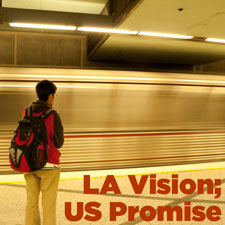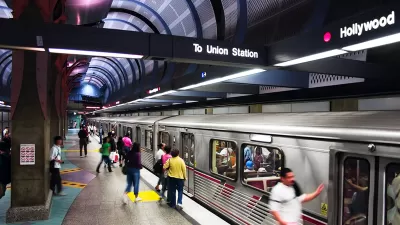Long known as a land of sprawl and disconnected communities, Los Angeles has emerged as a leader in transit investments, providing forward-thinking leadership for how infrastructure finance can and should continue, even in difficult financial times, writes Allison Brooks and Darnell Chadwick Grisby of Reconnecting America.
The vision laid out by Mayor Antonio Villaraigosa and other civic leaders includes light rail linked to an expansive bus network connecting the cultural homes of the African-American, Latino, and Asian-American communities; a "subway to the sea" that runs through a heavily congested but jobs rich corridor, and a beautiful intermodal transit hub in a reinvigorated downtown. When Mayor Villaraigosa asked the federal government to loan the region money to accelerate this vision- making it happen in ten years instead of thirty-it captured the imagination of national policymakers and community stakeholders alike and began a conversation about how the federal government can support local innovation and help accelerate private and public investment in infrastructure without breaking the bank. This story began with a simple local tax measure.

In 2008, Los Angeles County voters approved Measure R, a half-cent sales tax, and did so with a two-thirds majority. The measure pays for 30 years of transportation improvements connecting people to each other and to economic opportunity throughout the county. Knowing that the county would generate these resources over time, but antsy to accelerate the pace of investment so that community benefits could be achieved sooner, the mayor has advocated for the federal government to provide a series of loans to be paid back using those sales tax receipts. As a result, what would have taken 30 years to complete, could potentially only take 10 years. The idea has gained national currency as a mechanism through which the federal government can work in partnership with local governments and the private sector to improve regional mobility, get people back to work, and build healthier and more equitable communities. This vision has been coined "America Fast Forward". This proposal has generated a tremendous amount of excitement among a diversity of stakeholders in Los Angeles County, including business, community based groups, housing and commercial developers, labor unions, philanthropy, and environmental stewards, among others.
People from all walks of life recognize that this accelerated transit investment will have a huge impact on the communities along existing and new transit corridors. In particular, many folks want to take proactive measures to ensure that the low-income and moderate income people currently living along these transit corridors will stand to benefit from this investment, and not get displaced because the communities they have lived in for years and years have suddenly become more desirable and better connected to the regional economy.
This latter challenge begs the question: With transit construction on an accelerated path, how can "America Fast Forward" also fosters the acceleration of community benefits-such as affordable housing development and preservation, provision of childcare centers, grocery, finance, and health services, and other community amenities near transit– so that all people are on the proverbial train, and not left in its tracks? After all, as data shows year to year, it is low and moderate-income people who use public transit the most. Having access to quality public transit offers people the ability to save money on transportation and spend it on other things. Some structural challenges make aligning the pace of transit investment with the pace of community development a complicated but not impossible endeavor. These include:
- Transit investments are made at the regional scale, often across jurisdictions, while most housing and community development investments are made at the project or neighborhood scale making it more challenging to align planning processes.
- Because transit agencies and city and county planning, housing and economic development staffs report to different agencies and are focused on meeting different performance expectations, there is not a lot of incentive for transit agencies and city and county departments to work together on community development activities around transit nodes.
- There is no dedicated source of station area planning dollars in the region, state, or at the federal scale. Moreover, such planning is a low priority with transit agencies who perceive that such planning efforts will slow down their timeline and potentially increase their costs.
- It is difficult to generate the resources to get out ahead of transit planning and construction to set aside land for the purposes of affordable housing or other amenities that will ensure needed transit ridership down the line. Not doing these things now could result in prohibitively high land costs in the future.
While it most often falls on local jurisdictions to take on station area planning and land acquisition, this can be a deep burden for cities struggling to cover their basic daily public safety costs. Moreover, with a growing number of regions passing similar sales taxes and anticipating that the federal government will accelerate transit expansion, it makes more sense to set national standards for how regions will make the most of these critical investments and provide the incentives for them to do so. Some of this can happen through enhancements to existing federal loan programs such as the Transportation Infrastructure Finance and Innovation Act (TIFIA), and by getting federal agencies on the same page in terms of defining the kinds of community outcomes expected from federal investments. But ultimately, this needs to occur at the local level through better coordination of transit agencies with city and county departments, including streets, planning, housing and economic development and with the individuals and families who are ultimately the most impacted by the outcomes of these investments.
Allison Brooks is Chief of Staff and Darnell Chadwick Grisby is Deputy Policy Director at Reconnecting America.

Planetizen Federal Action Tracker
A weekly monitor of how Trump’s orders and actions are impacting planners and planning in America.

Canada vs. Kamala: Whose Liberal Housing Platform Comes Out on Top?
As Canada votes for a new Prime Minister, what can America learn from the leading liberal candidate of its neighbor to the north?

The Five Most-Changed American Cities
A ranking of population change, home values, and jobs highlights the nation’s most dynamic and most stagnant regions.

San Diego Adopts First Mobility Master Plan
The plan provides a comprehensive framework for making San Diego’s transportation network more multimodal, accessible, and sustainable.

Housing, Supportive Service Providers Brace for Federal Cuts
Organizations that provide housing assistance are tightening their purse strings and making plans for maintaining operations if federal funding dries up.

Op-Ed: Why an Effective Passenger Rail Network Needs Government Involvement
An outdated rail network that privileges freight won’t be fixed by privatizing Amtrak.
Urban Design for Planners 1: Software Tools
This six-course series explores essential urban design concepts using open source software and equips planners with the tools they need to participate fully in the urban design process.
Planning for Universal Design
Learn the tools for implementing Universal Design in planning regulations.
New York City School Construction Authority
Village of Glen Ellyn
Central Transportation Planning Staff/Boston Region MPO
Institute for Housing and Urban Development Studies (IHS)
City of Grandview
Harvard GSD Executive Education
Regional Transportation Commission of Southern Nevada
Toledo-Lucas County Plan Commissions



























